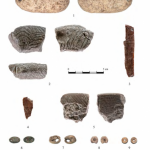Oldest Spindle Whorls Found in Israel: Early Textile Tools Rewrite Levantine History
Jerusalem, 13 November, 2024 (TPS-IL) -- Researchers uncovered 12,000-year-old spindle whorls in northern Israel, predating previously known textile tools in the region by 4,000 years, Hebrew University announced on Wednesday.
The artifacts, associated with the Natufian culture, mark a pivotal moment in human technological development as societies transitioned from hunting and gathering to agriculture.
A spindle whorl is a small, weighted tool used in spinning fibers into yarn or thread. It is typically a round or disk-shaped object with a hole in the center, designed to be attached to a spindle stick, which is a thin rod. Together, they form a simple tool for transforming raw fibers, like wool, flax, or cotton, into usable thread for weaving or other textile processes.
The study, led by Talia Yashuv and Professor Leore Grosman from the Hebrew University’s Institute of Archaeology, used advanced digital 3D modeling to analyze more than 100 perforated limestone pebbles recovered from the Nahal-Ein Gev II dig site near the Sea of Galilee.
Experimental replicas successfully demonstrated their function, affirming their role in early textile production.
“These Natufian perforated stones are actually the first wheels in form and function,” Grosman explained. “They represent an early iteration of wheel-based technology, long before the invention of the wheel for transport.”
The Natufians, who lived 11,500-15,000 years ago, were among the earliest groups to settle in permanent or semi-permanent villages. They built stone and mud structures, some of which included circular or oval houses with stone foundations.
“This study emphasizes the Natufians’ role as technological pioneers,” said Yashuv. “Their innovations laid the groundwork for future breakthroughs like the potter’s wheel and the cart, shaping the trajectory of human history.”
The findings were published in the peer-reviewed PLOS ONE journal.







